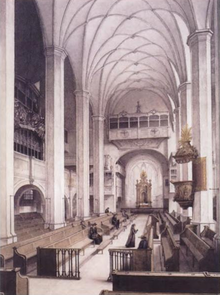Loading AI tools
From Wikipedia, the free encyclopedia
Johann Sebastian Bach composed the church cantata Ihr, die ihr euch von Christo nennet (You, who call yourselves of Christ),[1] BWV 164 in Leipzig for the 13th Sunday after Trinity and first performed it on 26 August 1725.
| Ihr, die ihr euch von Christo nennet | |
|---|---|
BWV 164 | |
| Church cantata by J. S. Bach | |
 Thomaskirche, Leipzig | |
| Occasion | 13th Sunday after Trinity |
| Cantata text | Salomon Franck |
| Chorale | Herr Christ, der einig Gotts Sohn |
| Performed | 26 August 1725: Leipzig |
| Movements | six |
| Vocal | SATB solo and choir |
| Instrumental |
|
Bach wrote the cantata in his third year in Leipzig for the 13th Sunday after Trinity. He used a cantata text written by Salomon Franck in Weimar, published in Evangelisches Andachts-Opffer in 1715,[2] as he had done already in Tue Rechnung! Donnerwort, BWV 168, four weeks before.[3] The prescribed readings for the Sunday were from the Epistle to the Galatians, Paul's teaching on law and promise (Galatians 3:15–22), and from the Gospel of Luke, the parable of the Good Samaritan (Luke 10:23–37). The love of one's neighbour is the dominant theme of this cantata, whereas in the two preceding years the cantata texts of Du sollt Gott, deinen Herren, lieben, BWV 77, and Allein zu dir, Herr Jesu Christ, BWV 33, had stressed the equality of loving God and neighbour.[3] The closing chorale is the fifth (and last) verse of Elisabeth Cruciger's hymn "Herr Christ, der einig Gotts Sohn" (1524).[4]
Bach first performed the cantata on 26 August 1725.[3]
As in several other cantatas on words of Franck, the setting is intimate: soprano, alto, tenor and bass soloists, two flauto traverso, two oboes, two violins, viola, and basso continuo. A four-part choir is only needed for the closing chorale, if at all. The cantata is in six movements:[3]
The music for four soloists and a few instruments is essentially chamber music. Bach sets the arias in forms which deviate from the standard da capo aria. In the tenor aria the strings and the voice share a theme, which appears in two similar halves, A B A' B'. In the alto aria, accompanied by sighing motifs in the flutes, the second section is repeated rather than the first, A B B'. In the duet Bach achieves a quartet, adding to soprano and bass voice the high instruments in unison and the continuo. The text is presented in three sections and repeated completely in a fourth section, which imitates the first. The closing chorale is a four-part setting.[3]
Seamless Wikipedia browsing. On steroids.
Every time you click a link to Wikipedia, Wiktionary or Wikiquote in your browser's search results, it will show the modern Wikiwand interface.
Wikiwand extension is a five stars, simple, with minimum permission required to keep your browsing private, safe and transparent.